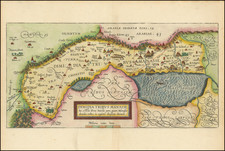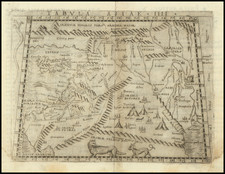The First Scientific Mapping of Jerusalem – A Watershed in the Exploration of Jerusalem and its Past
Nice example of this highly important survey of Jerusalem, executed by the Ordnance Survey.
At a scale of 1:2,500, this is the detailed map that accompanied the official report of the Ordnance Survey mission to Jerusalem, published in 1865.
The map shows the layout of the Old City, divided into quarters. The Armenians clustered near the Zion Gate in the south, the Christians near the Church of the Holy Sepulchre in the northwest, the Jews near the Western Wall (known in the West as the Wailing Wall), and the Muslims around the Haram ash-Sharif, or Temple Mount.
The map shows an entrancing level of detail. The old city walls are evident, as are roads and buildings. Cisterns are prominently marked, a nod to the water issues that inspired the survey. Elevation lines radiate around the city’s hills.
Many notable Jerusalem landmarks are easily recognizable here, including the Western Wall, Dome of the Rock, the Muristan (site of the Hospital of the Knights of the Order of St. John), and the Citadel. A reference list to the left lists 81 sites of interest that are keyed to numbers on the larger map.
Some of the surrounding countryside is also shown, with many trees, tombs, and a cemetery for each of the three major Abrahamic faiths. To the northwest of the city is a massive compound labeled “Russian Property.” This is the Russian pilgrimage site which had only recently been built when this map was published. Previously a staging site for Crusaders attempting to take the city, the Imperial Orthodox Palestine Society built the compound seen here from 1860 to 1864. It later was the center of British government administration during the British Mandate.
Ordnance Survey of Jerusalem
The Ordnance Survey of Jerusalem of 1864–65 produced the first scientific mapping of Jerusalem. It was also the first Ordnance Survey to take place outside the United Kingdom.
The survey grew not out of British defense interests—the Ordnance Survey was placed under the War Department in 1855—but out of a patrician concern for clean water in the Holy Land (although there were also clear imperial motives). James Finn, a previous Jerusalem Consul, Lord Shaftesbury, and Alexander McCaul of the London Jews’ Society were among some of the worthies who formed the Water Relief Fund in 1864. They raised funds, primarily from the heiress Angela Burdett-Coutts, to finance a group of Royal Engineers to survey the ancient city.
The survey was entrusted to Charles William Wilson, a 28-year-old officer in the Corps of Royal Engineers of the British Army. The team of six Royal Engineers began their work on October 3, 1864 and completed it on June 16, 1865. Carl Sandreczki, of the Church Mission Society, helped the survey team. With two assistants, he made a list of place names, including streets, buildings, and points of interest. Their list included names in Arabic, saving information that might otherwise have been lost.
Unfortunately, the survey identified no new sources of water and that matter was largely sidelined over the course of the survey. Indeed, the desire for information that could lead to increased British control and presence in the Holy Land seemed to be the real motive. The survey did, however, produce the most detailed map of the city to date and the first scientific mapping of the holy settlement.
One of the survey's most significant aspects was that it was the first to investigate the underground features of Temple Mount, including its cisterns, channels, and aqueducts. This led to the discovery of forgotten features, including an arch that used to support a bridge into the Temple Mount complex; the site is immediately adjacent to the Western Wall. The arch was named for Wilson and still carries that name today.
Wilson also carried out ground-breaking work on measuring the elevation of the city. He and his team used triangulation to create the map and marked ground level measurements every ten feet. The survey was ultimately able to discern the difference in elevation between the Mediterranean and the Dead Sea, and for the first time measured the latter at a then-correct level of 395 meters below sea-level.
Archaeologist Shimon Gibson summed up the legacy of the Ordnance Survey of Jerusalem as follows:
What is quite clear is that a major change in the character of the exploration of ancient Jerusalem occurred in the 19th century, with a fascination for the past of the city, fanciful or otherwise, being replaced by that of a scientific concern for the tangible antiquities of the city. The Ordnance Survey conducted by Wilson in 1864 and 1865 marks this turning point. The ancient past of Jerusalem was no longer a matter for armchair scholarly discourse, turning upon the credibility and background of a given scholar, but had now become a matter for clear-cut scientific rigor, which could only be based on facts obtained in empirical fashion, whether through the taking of exact measurements, photography, or excavations in the ground.
The survey also served as the impetus for the founding of the Palestine Exploration Fund, which first met on June 22, 1865. Wilson was appointed as the first Chief Director of the Fund.
States of the map
The maps was first published in 1865 and revised in 1871 and 1876. A reduced-size version of the map was also produced in 1868.
Significance
Over a century after the survey, Dan Bahat described this map as “a watershed in the exploration of Jerusalem and its past.” The Jerusalem Post commented that Wilson's efforts “served as the basis for all future Jerusalem research.”
The map was the most accurate map of the city for seventy years, when the British Mandate’s Survey of Palestine published a map of the Old City at a scale of 1:2,500 in 1936.











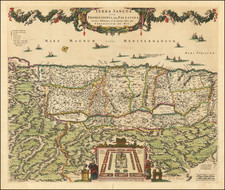
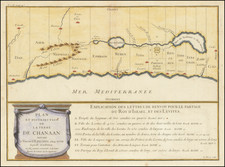
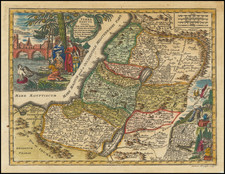
![[Holy Land, Cyprus, Syria & Middle East] Asiae IIII Tab](https://storage.googleapis.com/raremaps/img/small/96376.jpg)
